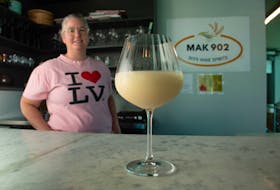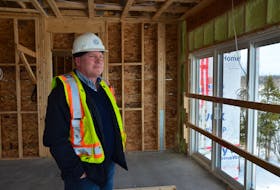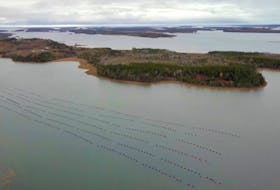METEGHAN RIVER, N.S. — For three years they thought about it before finally taking the leap. Now the excitement and pride that Joel German and David Saulnier feel standing outside the home they’ve constructed in Meteghan River, Digby County, is almost impossible to sum up in words.
So let’s sum it up in numbers instead.
The two men, business partners in JD Composites Inc., have constructed the first-ever home built out of 100 per cent recycled standard plastic bottles using PET (polyethylene terephthalate) core foam green technology.
It’s estimated that 612,000 plastic bottles (give or take 15,000) were manufactured into panels used in the construction of the 2,000-square-foot home.
“There are four major companies building this material in the world and they’ve told me that we’re the only people, on planet earth, that have done this so far,” Saulnier says about using PET foam to construct a house.
“This is exciting as myself and David have worked for 10 months with a small crew of two to three people to complete a 2000-square-foot-luxury beachfront home to show everyone what can be done when recycling is put as a first priority,” German adds.


German holds two jars. One contains tiny pieces of mulched up plastic bottles. The other, tiny pellets made from those mulch fragments. He explains the process from mulch to pellets, and beyond, that was done at the Armacell plant in Ontario.
“It goes through a heating process and it’s made into little pellets,” he says. “All of these pellets go into big vats and it goes into a building the size of Walmart. Four guys operate this plant and they dump it into a hopper. It gets mixed with gases. It melts it down and makes it come out in a foam, like shaving cream it expands on the way out.”
As the material expands German says it’s as soft to the touch as a blade of grass.
But it doesn’t stay that way.
“They’ve got these big cooling plates made out of steel that come on top and it follows a chain about 50 metres long and it gets cut as the whole automated process goes along,” he says.
Other than the fibreglass skins they’ve added to the foam, the core material used in the construction of their house is all recycled green tech German says.
And to say it’s durable is an understatement.
Consider this.
Test panels were sent to Exova testing facilities in Mississauga where they withstood 326-mp/h (524-km/h) sustained wind force, which is twice the strength of a Category 5 hurricane. This was with a quarter inch of wind deflection on an eight-foot-by-eight-foot square-foot panel.
“Engineers were shocked by these results, not because they maxed out the wind chamber, but because they loaded the panel by hand in the chamber,” says German, noting it’s a lightweight material, as opposed to something heavy such as concrete.
Aside from its strength, the home is also very efficient.
“We are at a continuous R-30 with no thermal breaks making it 2.3 times the efficiency of a normal home,” German says. “This makes for energy great long-term savings over a 25-year span.”
Says Saulnier, “The house is rot resistant, mildew resistant, termite resistant in warmer climates. It’s just an efficient, structurally insulated panel made with green material.”


Saulnier says when he and German brainstormed on a unique composite project, he knew PET technology would be the way to go.
“I said I know we could use it in a foam state, design some fiberglass skins for each side and come up with a structure well enough for a house,” he says.
Saulnier has built composite homes in the past, and also composite storage facilities. He’s built them in Iqaluit, the Dominican Republic, China and Nova Scotia, although that was using different types of panels, a different process and nothing recycled.
“So I took my experience and Joel and I talked about it and we came up with this,” he says. “We’re pretty happy with it . . . We jumped in full force.”
The shell of the house is fiberglass skins, on the inside and outside, covering the core foam. It is UV protected with paint.


“We put siding on the house just for looks, because it’s the first one and we wanted to make a statement and have it stand out and pop a little bit,” German says. “However, we wouldn’t have had to put anything on it. We could have made it look like a stucco finish and given it a rougher texture.”
The did do that on a portion of the roof, which has no shingles.
The house includes a full kitchen, dining area, a living room, a room where they are hoping to have an indoor electric or propane BBQ grill, three bedrooms, two bathrooms and a roof-top deck that gives you an expansive view of Clare stretching from Meteghan to Church Point.
The intention of the property is for it to be a showhouse and an AirBnB. But it will also be listed for sale.
“If it doesn’t sell it’s fine. It’s our first one. We’re sort of attached to it,” German says.
He adds that they’d like to go into different avenues with this product, as there are a lot of possibilities and opportunities.
“There’s a lot more than just building a few custom homes a year,” he says. “There could be hurricane or disaster relief shelters, hunting cabins, sheds, you name it.”

The big reveal of the house took place on Monday, June 24, during an open house. But before that word was already out about what JD Composites was doing. As you can imagine it generated a lot of interest and curiosity. Vehicles would continuously drive by, with people stopping to have a look. The house is located on Sunset Lane in Meteghan River. The Acadian community is about a 25-minute drive from Yarmouth, N.S.
Last year the Government of Canada announced a repayable contribution of $109,690 towards the project through ACOA’s Business Development Program, which supports small and medium-sized companies to become more competitive, develop new export markets and explore innovation.
Meanwhile, after the foam process was completed in Ontario, the panels used to build the home were manufactured and pre-engineered over a timeframe of about three-and-a-half weeks closer to home at the engineering warehouse at ECO-Park in Meteghan. The entire house structure was assembled in about 14 hours. But, of course, that was just the start of things. Construction started last year, with a three-month break over the winter and then they got going again in March.
Cost wise, if people wanted to build a house like this the builders say it’s similar to what you would pay if you were building a typical house.
But this house like this certainly isn’t typical and the efficiency is also where you get added value.
Plus there’s the bragging rights of living in a house that is an ultimate example of recycling.
Asked what they hope is the biggest takeaway from this project, German says, “We hope to start something bigger than what this is. Yes, this is a house, but the ideology behind all of this, we are helping to create a better market for recycling, for pop bottles, water bottles.”
One thing is certain, it sure beats a recycling bin.
Or worse yet, seeing plastic bottles end up in a landfill or the ocean.
FYI...
THINGS TO NOTE ABOUT THIS INNOVATIVE TECHNOLOGY:
1. GREEN TECHNOLOGY : The construction of this home saved an estimated 612,000 plastic bottles from going into oceans and landfills by finding a new market for recycling plants. Other than the fibreglass skins on the foam the core material is all recycled green tech. (Side note: For JD Composite's Forever Sheds – another project it displayed at the June 24 grand opening – they are averaging anywhere from 15,000-25,000 recycled bottles per build in 8x12’ to 12x12’ structures depending on the roof style and design.)
2. R-VALUE: In standard Canadian homes R-20 is typically used and 2x6 wooden studs every 16 inches are used for framing, each piece of wood creates a thermal break (thermal bridging) and reduces the R-value from R-20 down to R-13. This PET plastics home has been ASTM certified for North America/Europe and is at a continuous R-30 with no thermal breaks making it 2.3 times the efficiency of a normal home. This makes for energy great long term savings over a 25 year span.
3. STRENGTH: Test panels sent to Exova testing facilities in Mississauga proved to withstand 326 mph sustained wind force which is twice the strength of a Category 5 hurricane. The result was a quarter inch (0.25”) of wind deflection in our 8 foot by 8 foot (64sqft) panel.
4. A FIRST: This style of house along with the materials used is the first of its kind in the world. Similar houses have been tested but none using PET core foam: plastic bottles mulched up, made into pellets, then extruded into a foam core more rigid than styrofoam.
5. DESIGN FREEDOM: Since this core gets put together using newer fibreglassing methods the company can literally make any design it chooses and can strengthen as needed using different fibreglass layups depending on the weight load, etc. Skylights, for example, sit on a combings made of the same material where they literally never leak, so adding natural light to save power becomes maintenance free.
6. MAINTENANCE : Because JD Composite's products use marine construction, they know the lifespan is much greater than traditional wood construction, so you don’t need to put siding or roofing if you'd rather not. With proper installation of vinyl doors and windows rotting is no longer an issue. The core material is a closed cell system so even if something is to puncture the surface and pass through the skins and reach the core, it still cannot rot and spread the rest of the structure like other materials would do. This material is also impermeable to rot.
7. OFF-GASSING: The product offgasses for 72 hours at the Armacell manufacturing plant in Brampton, Ontario, where the raw panels are made. After that they are no longer emitting any gasses or chemicals into the environment. Fibreglass resin smell also goes away in 48-60 hours after skin application. JD Composites has brought many visitors through the show home and they could only smell fibreglass if they had glassed something that day or previous day. For the most part they could only smell the wood used in the walls.
8. FLOATATION: The material is extremely buoyant. This means it’s marine application is perfect. The technology can be applied to wharves and gangways JD Composites started supplying boat shops in southwest Nova Scotia with marine core GR-115 which is more dense than their housing core GR-70. So now some of the boats built locally will have their bulkheads and lazarettes made of our core material averaging around 60,000-75,000 recycled pop bottles per boat.
9. SCALEABILITY/SPEED: JD Composites can build pre-engineerd structures in a matter of days. Their 2000 SQFT custom home was built by 3 guys in three weeks at the engineering warehouse (ECO-Park aka old EM Comeau sawmill in Meteghan) and it was assembled in 14 hours. With a crew of 8-10 workers they can build sheds in one day and produce volume to feed the demand. Scaling up the production is very easy and very affective.
9. EMPLOYMENT: They see lots of opportunities for jobs in the future.








